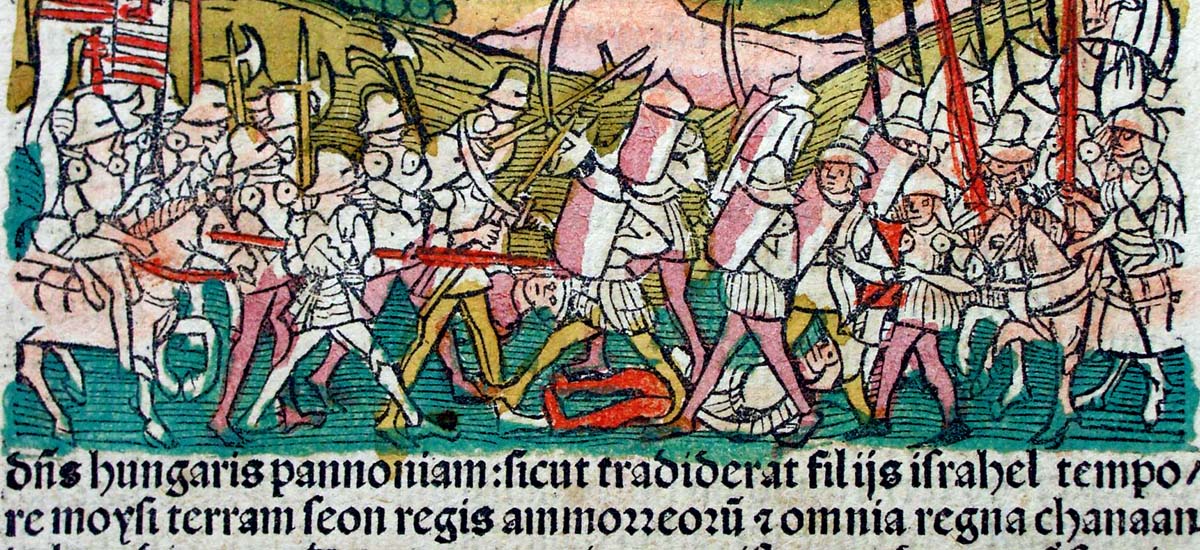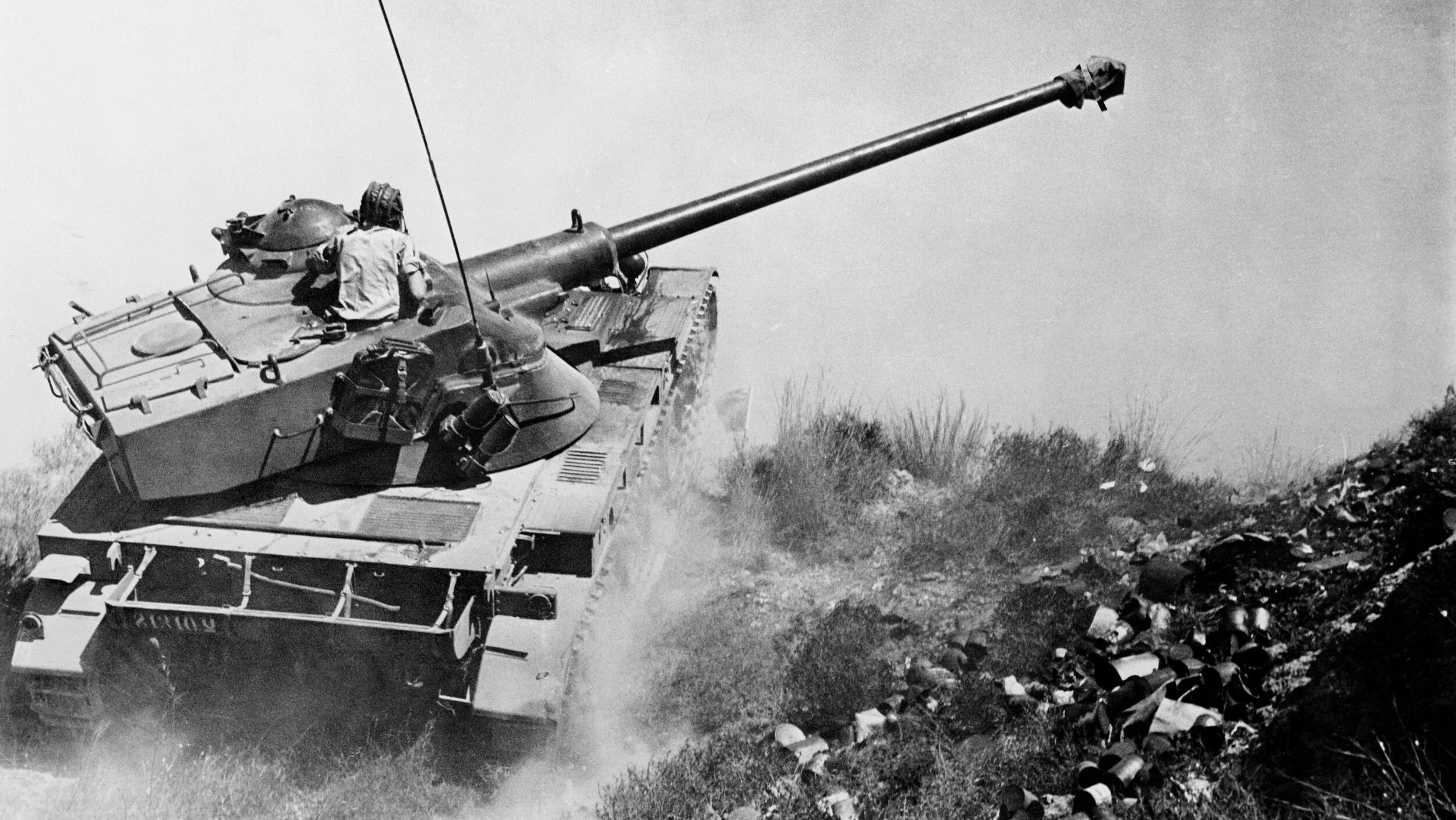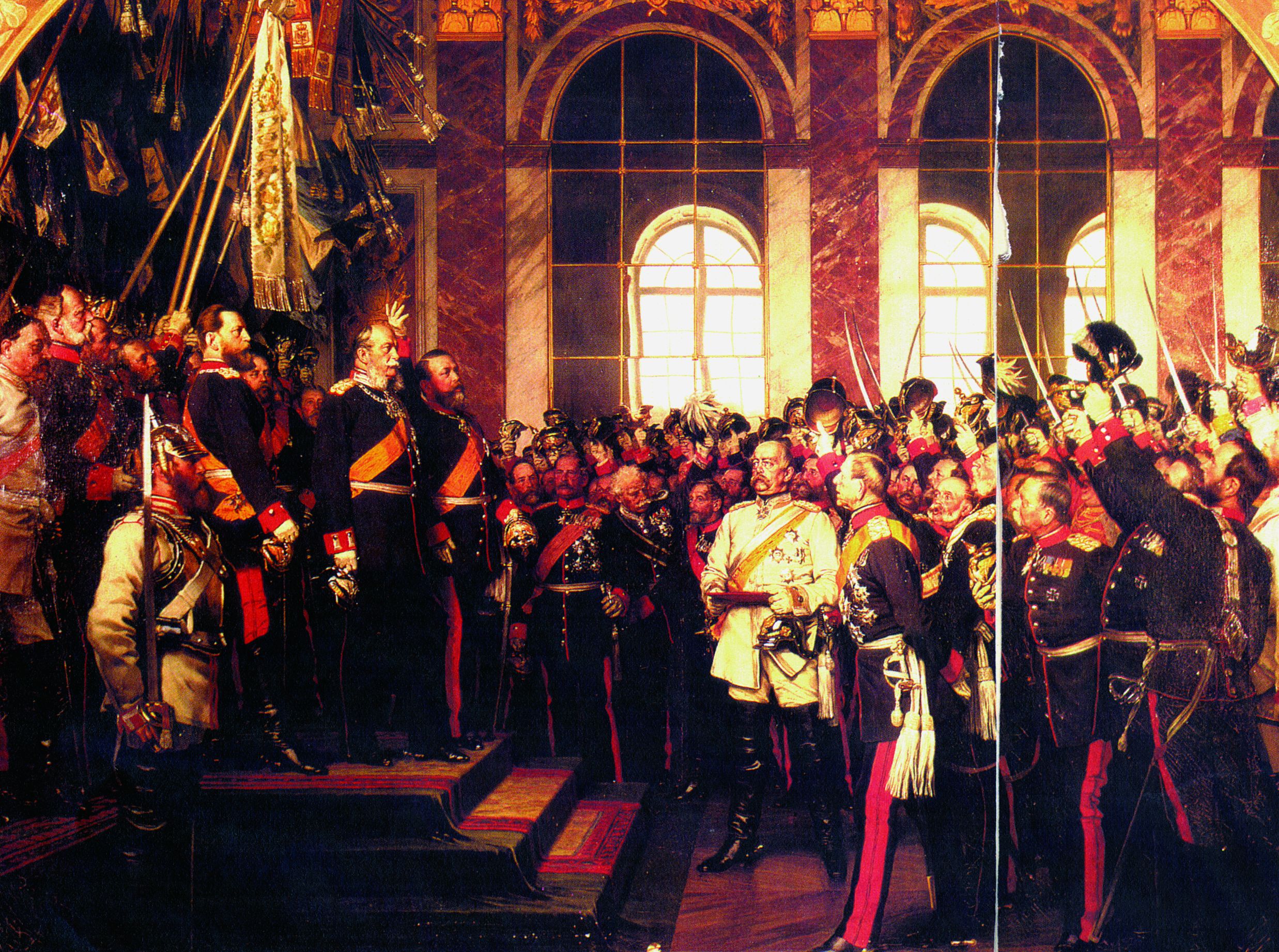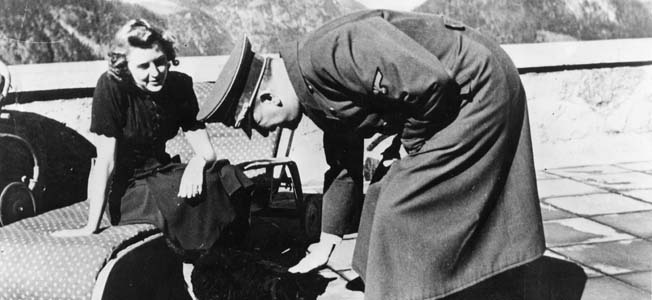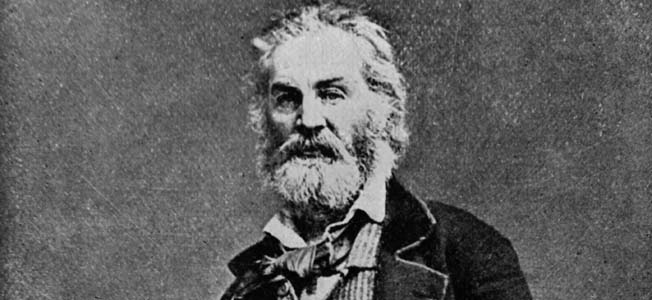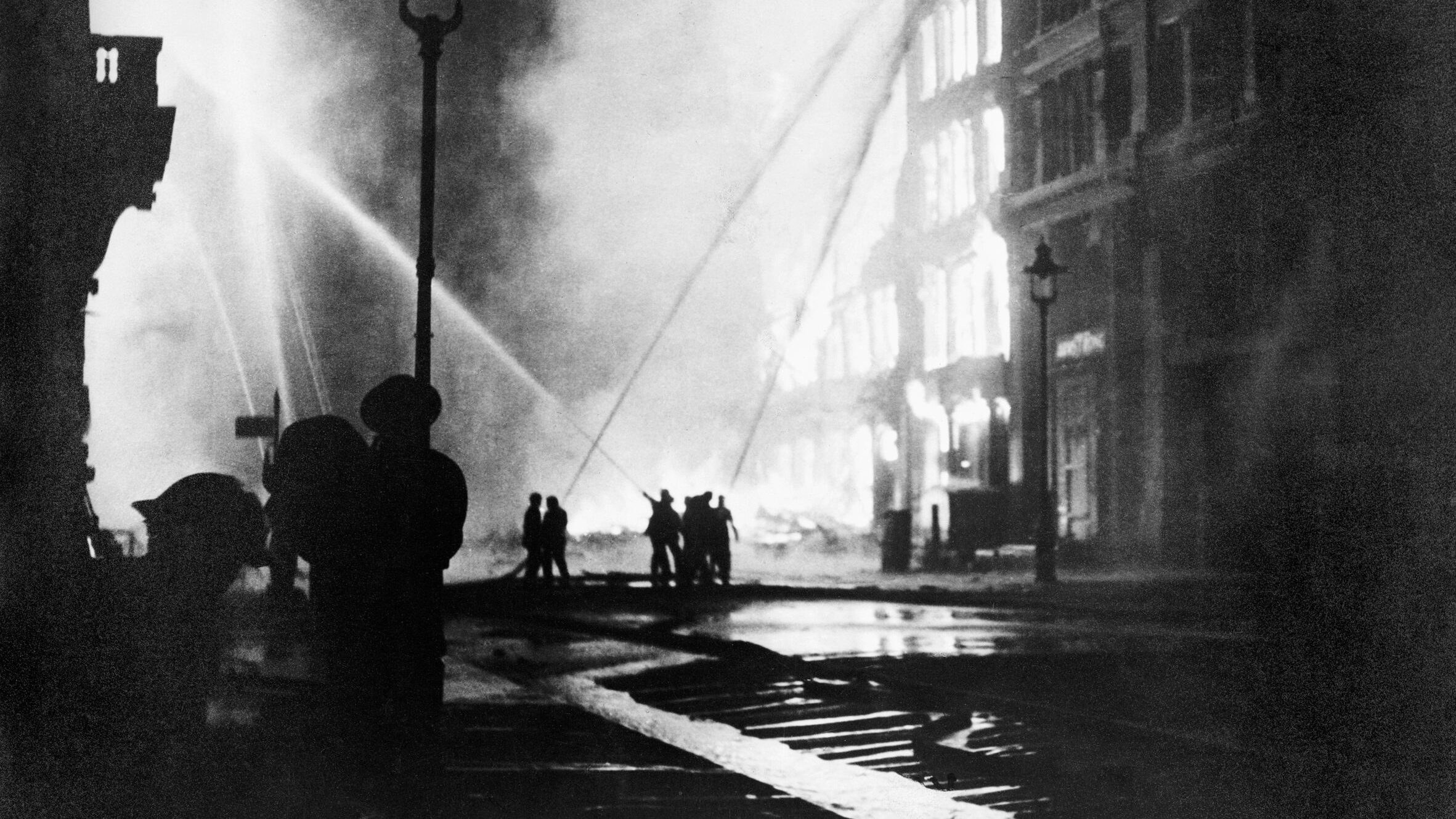By William E. Welsh
Encased in mail and armor, the soldiers of the Kingdom of Hungary’s Black Army stood rigidly at attention on a warm summer day in late August 1487 at Wiener Neustadt in Lower Austria. Their capture of the town came at the end of a long conflict between archrivals King Matthias Corvinus of Hungary and Frederick III, Holy Roman Emperor and Archduke of Austria.
Astride his imposing war horse, the Hungarian monarch rode slowly past the troops, stopping occasionally to bestow rewards on units that had shown great valor fighting Frederick’s Imperial forces. The Black Army assembled that day consisted of 20,000 cavalry and 8,000 infantry, according to Antonio Bonfini, who was Matthias’s royal historian. In addition to native Hungarians, the army included Czechs, Moravians, Silesians, and South Slavs, all of whom belonged to a Hungarian empire that Matthias had carved out through conquest over a quarter century following his election to the throne by the Hungarian Diet in 1462.
After the inspection was over, the units performed a variety of maneuvers for the Hungarian aristocrats and foreign dignitaries in attendance. They reorganized themselves crisply and seamlessly into a number of Matthias’s favorite battle formations, such as the circle, triangle, square, and wedge. They also fashioned themselves into a unique formation known as the scorpion, The shape of which resembled the predatory arachnid. Heavy and light cavalry formed the pincer claws, while heavy and light infantry made up its abdomen.
The reign of Matthias Corvinus, son of the famous Hungarian generalissimo Janos Hunyadi, marked the apex of power for medieval Hungary. Matthias is noted not only for holding back the Ottoman hordes from overrunning Hungary, but also for campaigns of conquest in the Kingdom of Bohemia and the Archduchy of Austria. When Matthias died in 1490, his Hungarian empire stretched from Brandenberg in the north to Serbia in the south. It was a remarkable achievement for a man whose low-born father had risen to become one of the greatest military commanders of the Middle Ages.
Following the death in 1439 of Albert the Magnanimous, who held the crowns of Bohemia, Croatia, and Hungary, the Realm of St. Stephen, as Hungary was known, underwent a period of instability. Instead of selecting Albert’s infant son, Ladislas the Posthumous, the magnates of the Hungarian Diet instead chose King Wladyslaw III of Poland as their king because they believed he was better qualified to protect them from foreign aggression.
However, Ladislas’s mother, Elizabeth, ultimately compelled the Hungarian Church to crown her three-month-old son on May 15, 1440. Elizabeth intended to serve as regent, and she enlisted the support of her cousin, Frederick, the Duke of Inner Austria and future Holy Roman Emperor, to serve as her son’s guardian.
Although Wladyslaw was slain by the Ottoman Turks in the epic clash at Varna in 1444, Elizabeth still had to contend with Hunyadi, who the Hungarian magnates elected to serve as their governor with full regal authority in 1446. He served in that capacity for seven years until his death in 1453.
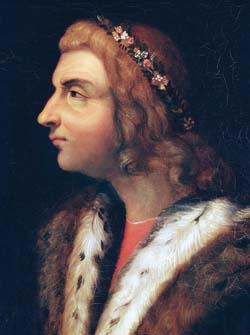
Matthias, who was Hunyadi’s second son, was born on February 23, 1443, in Cluj in the principality of Transylvania. He began fighting alongside his father at the young age of 12 and was exposed to the ferocity of the Ottoman army during the Siege of Belgrade in July 1456. In many ways Hunyadi’s glorious victory over Suleiman’s army at Belgrade was payback for their defeat at Varna. Matthias, who fought with great valor in the desperate siege, was knighted after the battle. Hunyadi, who was weakened by the hard-fought defense of Belgrade, succumbed to the plague shortly afterward.
The Hungarian monarch was not a hereditary kingship like most monarchies in Western Europe at the time; instead, the Hungarian Diet elected the king. It was a process that dated back to 1382. A king might be native born or foreign born. The Diet was composed of both wealthy magnates and threadbare barons.
A power struggle ensued upon Hunyadi’s death between Ladislas the Posthumous and Hunyadi’s eldest son, Ladislas Hunyadi. Some members of the Diet sought to replace Ladislas the Posthumous with Ladislas Hunyadi. Count Ulrich of Cilli, one of the most powerful magnates in Hungary and a long-time foe of the Hunyadis, took it upon himself to become Ladislas the Posthumous’s protector. But Ulrich was disliked by many members of the Hungarian Diet. When the Diet convened in 1455 it stripped Ulrich of his authority. This was unpalatable to Ladislas the Posthumous, and the young monarch responded by elevating Ulrich to captain-general of Hungary with control of its military forces.
When false accusations were made against Ladislas Hunyadi that he was not willing to pay debts owed by his father to the crown, he convincingly defended himself before the Hungarian Diet when it met the following year. Ladislas Hunyadi had inherited from his father a number of royal castles, as well as the fortress at Belgrade where he resided.
In the late autumn of 1456, 16-year-old King Ladislas and Count Ulrich set out together for Belgrade to receive the forfeiture of the city from Ladislas Hunyadi. The forfeiture had been arranged as part of the reconciliation between the two rivals. Ulrich, who brought with him a company of mercenaries, intended to slay Ladislas Hunyadi. But Ladislas Hunyadi disrupted his machinations when he refused to let the count’s mercenaries enter the fortress.
Shortly after the meeting convened at Belgrade on November 9, 1456, the count tried to slay Ladislas Hunyadi with his sword, but Ladislas Hunyadi’s guards rushed to their lord’s aid and thrust their swords into the count.
In the aftermath of the scuffle, King Ladislas granted his rival amnesty; however, he later arrested both of Hunyadi’s sons. In March 1457 Ladislas Hunyadi was executed for plotting against the king. The ensuing backlash from the Hungarian nobility was so great that King Ladislas fled to Bohemia where he died unexpectedly 11 months later. The death of Ladislas the Posthumous, who died childless, marked the end of the Albertinian line of the House of Hapsburg.
At the time of the king’s death, Matthias was being held in Prague in the custody of Hussite leader George of Podebrad, who had seized power as governor of Bohemia in 1448. Although Emperor Frederick III held the crown of Bohemia at the time, Podebrad usurped his authority and seized the throne in 1457. Young Matthias became engaged to Podebrad’s daughter, Catherine, but because of her extreme youth the wedding was put off for a future date. Podebrad subsequently freed Matthias so that he might be considered for the Hungarian throne. Podebrad did this for self-serving reasons for it was to his advantage to have his son-in-law in such a powerful position.
Matthias benefitted from widespread support among the Hungarian nobility. He also had the endorsement of papal legate Cardinal Juan Carvajal, who had great admiration for Matthias’s father. Fearing that he might be murdered by enemies, Matthias asked his future father-in-law to give him 500 mounted troops for protection.
Matthias subsequently was elected king on January 24, 1458, by a majority of the Hungarian nobles. The 15-year-old king arrived in Buda the following month. Although Michael Szilagyi had served briefly as regent for Matthias, the teenage king had every intention of beginning his reign immediately. He gave Szilagyi control of Bistrita County in Transylvania, but it was not a high enough post to satisfy his ambitions. When Szilagy refused to be sidelined, Matthias had him arrested. After a year in prison, Szilagy resigned himself to an ancillary role in Hungarian military affairs. He was captured and put to death by the Turks following a battle on the north bank of the Danube River at Bazias in 1460.
The biggest threat to Matthias’s rule, though, was Emperor Frederick III, who sought to add King of Hungary to his long list of titles. To reinforce his position as a legitimate king, Matthias needed to come to an agreement with Emperor Frederick III. Indeed, Frederick III held the Crown of St. Stephen. It had come into his possession for safe keeping during the ongoing baronial rebellions in Hungary. Pope Pius III intervened on Matthias’s behalf with the emperor in part because the Pope wanted Matthias to lead a crusade against the Turks. The negotiations, though, dragged on for five years.
Frederick III enjoyed the support of rebellious nobles in western Hungary. One of Frederick’s key allies, Hungarian magnate Ladislaus Garai, led a rebellion in 1459 in which as many as 30 nobles supported Frederick III’s quest for the Hungarian throne. But by that time Matthias had assembled enough troops that he was able to crush the rebellion. Matthias marched into western Hungary where he forced Garai and his allies to take an oath of fealty to him at Burg Gussing Castle.
In April 1463 Matthias reached a settlement with Emperor Frederick III. The agreement was ratified and signed by the parties the following year. One provision of the settlement called for the emperor to return the Crown of St. Stephen to Matthias. The agreement stipulated that Frederick was the titular king of Hungary, but that Matthias would be its ruling king. If Matthias failed to produce an heir, then the monarchy would revert to Frederick and his heirs. In addition, Matthias had to pay Frederick 80,000 gold florins. Matthias had postponed his coronation until such time as the Crown of St. Stephen was back in his possession. He was at long last crowned in a ceremony on April 29, 1464.
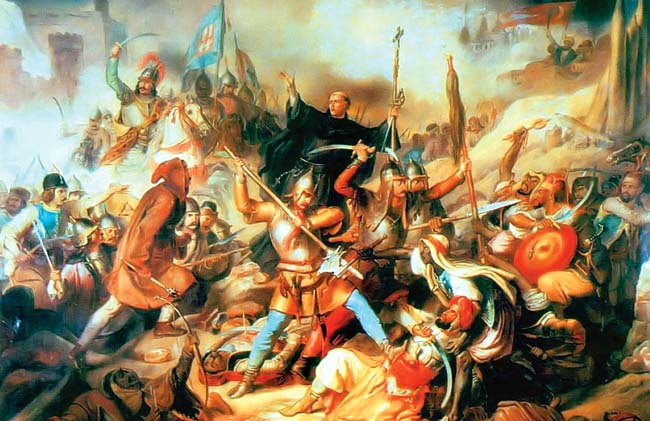
From his father’s experience battling the formidable Ottoman Porte, Matthias gleaned that it would be risky to engage in a pitched battle with the Ottomans. He therefore decided to fight limited wars against the Turks. His goal was to stabilize his southern frontier and not to try to retake Ottoman-controlled territory in the Balkans.
His first priority, though, was to consolidate his power. Afterward, he focused on molding a national army made up of professional soldiers supplemented by mercenaries or allies for campaigns. Matthias overhauled the banderial system whereby troops were recruited to serve the king. These reforms gave Matthias a professional standing army with a peacetime strength of 40,000 troops. Of this number, 16,000 were heavy cavalry, 14,000 heavy infantry, 8,000 light cavalry, and 2,000 musketeers. The artillery branch consisted of powerful bombards and culverins.
The groundbreaking Hungarian effort was comparable to that of French King Charles VII who established a standing army to drive the English from France in the final years of the Hundred Years War. Although not called the Black Army at the time, later generations referred to it as such because of the blackened armor the knights wore. What gave the Black Army a decisive advantage over its opponents was not its size, but rather the ability of the component arms to work seamlessly with each other.
Although Matthias’s had first-class heavy and light cavalry, the army always suffered from a serious shortage of professional infantry. In his 1475 campaigns against Mehmed the Conqueror’s army, he fielded 68,000 cavalry and 57,000 infantry. However, half of the troops in that campaign came from the Danubian Principalities.
While Matthias was busy securing control of Hungary after his election as king, Sultan Mehmed the Conqueror was steadily chipping away at the buffer zones that Hungarian King Sigismund had established in the early 15th century between Hungary and the Ottoman provinces. At the same time, Mehmed put pressure on the voivodes of Wallachia and Moldavia to ensure that they remained loyal vassals of the Ottoman Porte and not of the Hungarian kingdom.
Mehmed captured the Danubian fortress of Golubac in 1458 and then took the key fortress of Smederevo the following year. Additionally, Mehmed tightened his control over Bosnia and Serbia. He executed Bosnian King Stephen Tomasevic in May 1463 and drove the remaining members of the Brankovic dynasty out of Serbia. The Brankovics relocated to Hungary where they helped defend its southern border.
Matthias launched one of his limited offensives against Ottoman territory in 1463 following the departure of the sultan’s army at the end of the summer season. Although he initially had hoped to liberate northern Bosnia, Matthias resigned himself to capturing the walled hilltop fortress of Jajce. After a two-month siege that began in September, the victorious Hungarians took possession of the key fortress. Mehmed returned to try to retake Jajce the following year, but after subjecting it to 43 days of continuous bombardment he withdrew. A decade would pass before Matthias attempted similar operations on his southern frontier.
In 1467 Matthias crushed a rebellion in Transylvania. Afterward, he marched into Moldavia in an attempt to compel its voivode, Stephen of Moldavia, to recognize the Hungarian king as his suzerain. But Matthias did not realize that he was up against a first-rate opponent. While encamped in northern Moldavia in December of that year, Stephen led his troops in a stunning nighttime assault that routed the Hungarians. Stephen’s peasants fell upon the better armored Hungarians, driving them out of Moldavia. The defeat cured Matthias of wanting to exert control over Moldavia.
In 1468 Matthias went to war against his former father-in-law George Podebrad, the King of Bohemia. Matthias’s wife, Catherine Podebrad, had died four years earlier, and therefore he no longer had any ties to her father.
In his invasion of the Kingdom of Bohemia, Matthias enjoyed the support of Pope Paul II, who had excommunicated Podebrad in 1465 for his support of the protestant Hussites. The Pope went so far as to call for a crusade against Podebrad, and Matthias was eager to oblige the Holy See. Matthias’s first move was to invade and conquer Moravia where he threw his support behind the powerful Catholic nobility that opposed Podebrad. Afterward, he invaded Lusatia and Silesia.
The following year Matthias declared himself the King of Bohemia. Matthias’s audacious move prompted the Bohemians, Austrians, and Poles to form a triple alliance against him. When Podebrad died in 1471, the Bohemian Diet elected as its king 15-year-old Polish prince Vladislaus Jagiellon, who was the eldest son of Polish King Casimir IV. Pope Sixtus IV, who succeeded Pope Paul II, backed Matthias, while Frederick III supported Vladislaus.
A Polish-Bohemian army invaded Silesia and besieged Matthias’s army in Breslau, but the enemy mismanaged the campaign and ultimately quit the siege. The Hungarian light cavalry performed in an exemplary fashion during the Bohemian War. The fast-riding Hungarian horsemen conducted scorched-earth tactics, denying the enemy forage in the countryside and repeatedly attacking their supply lines. They also harassed the Polish and Bohemian troops on the march.
The Peace of Olomouc, signed in April 1478, brought an end to the decade-long Bohemian War. The treaty gave Vladislaus the right to rule Bohemia, and it bestowed upon Matthias the right to rule Moravia, Lusatia, and Silesia. Ironically, both Matthias and Vladislaus were given the right to call themselves King of Bohemia. Matthias emerged from the war as the victor given that he annexed the three prosperous provinces and added their revenues to his coffers.
In December 1475 Matthias once again focused on securing his southern frontier. He marched against the 1,200-man Ottoman garrison at Sabac in northern Serbia. The offensive was undertaken in part because a number of Hungarian magnates had accused Matthias of ignoring the damaging raids the Turks were launching into Croatia from their bases in Bosnia and Serbia.
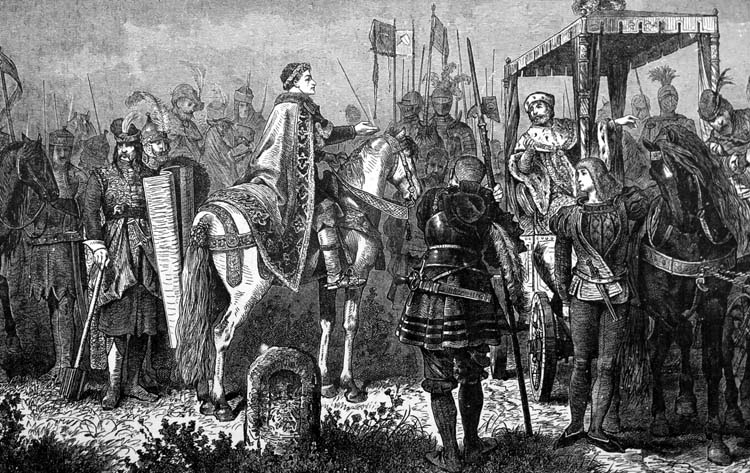
On January 15, the Black Army besieged Sabac fortress, which the Turks had built five years earlier. In anticipation of such an attack, the Turks had constructed a moat which they filled with water from the Sava River. They also placed logs against the walls of the fortress to further strengthen them against the anticipated Hungarian bombardment. When an Ottoman relief force sought to cut its way through to the garrison, Matthias soundly repulsed it. After 30 days of continuous shelling, the Turks capitulated. Afterward, Matthias led the Black Army east through the Danube Valley. He captured all of the strongholds between Sabac and Smederevo. The Ottomans were thrown on the defensive for the next several years for the Ottoman Rumelian army was to suffer key defeats at the hands of the Wallachians and Moldavians. Matthias’s able captain, Paul Kinizsi, succeeded in repulsing Ottoman forays into Transylvania, and he won a victory over the Ottomans at Breadfield in 1479. Two years later Mehmed the Conqueror died. His successor, Bayezid II, was far less aggressive.
Matthias’s war against Frederick III in Austria was intermittent. He besieged Vienna twice. The first time in 1477 he withdrew without capturing it; however, he did force the emperor into peace negotiations. War erupted again in 1482. Three Hungarian columns successfully isolated Lower Austria and captured its outlying fortresses, thereby isolating Vienna from external relief by Imperial forces. The Black Army besieged Vienna on January 29, 1485. In mid-May, the Hungarians stormed Leopoldstadt, the central district of the city. On June 1, the city surrendered to the Hungarians. After its capture, Matthias made Vienna his royal residence until his death five years later.
At the end of his reign, Matthias had added Silesia, Moravia, Lusatia, and the Archduchy of Austria to Hungary. Yet in 1490 he died without a male heir. The Hungarian nobles, who distrusted Frederick III, chose Vladislaus II for their next king. Although Vladislaus kept the Ottomans at bay, many of Matthias’s gains were lost.
Disaster lay on the horizon, though. Sultan Suleiman I crushed Vladislaus’s successor, 20-year-old King Louis II, at the Battle of Mohacs in 1526. At that point, the Ottomans absorbed two-thirds of Hungary, leaving behind a rump kingdom in the north that was nothing more than a buffer zone between the Ottoman Empire and Hapsburg Austria. The dismantling of Hungary made Matthias’s achievements seem even more impressive given the might of the Ottoman army. Matthias showed what a gifted statesman and commander could accomplish in 15th-century Europe.
